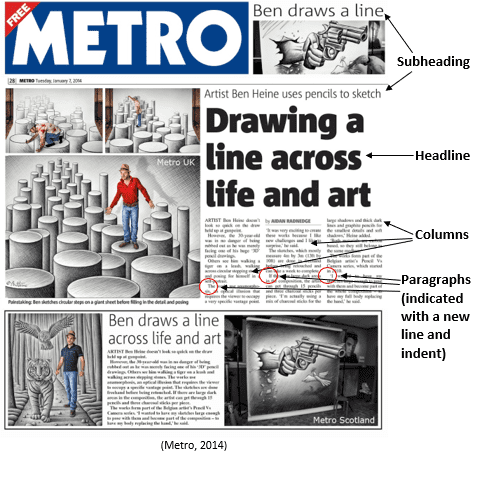As you may already be aware, there are a number of different magazines and newspapers out there. In the exam, you could get asked to write an article for any one of them, for example an article for a cooking magazine, a newspaper or perhaps a school newsletter. The type of magazine or newspaper that you are asked to write for and the purpose of the article will affect who your audience is (this will affect any piece you write, but we will discuss the audience of texts as a whole in more detail later). It is vital that you establish your audience before you begin planning your article. An example of a newspaper article has been provided below.

Although most magazine and newspaper articles include pictures (see above), you do not need to worry about this in the exam; what you need to write is purely textual; however, if you want to indicate the positions of images then a rectangular box with the word ‘image’ inside will suffice. A list of what should be included in a magazine or newspaper article is provided below:
- A headline: this is used to grab the reader’s attention to the story – it is a good technique to use alliteration and other language techniques in your headings.
- A subheading: this develops on from the headline and gives the reader more information on the story to grab their attention – again, it is a good technique to use alliteration and other language techniques in your subheadings as well. You may just decide to have one subheading below the headline or you may have a subheading before introducing each new paragraph of the article, if appropriate.
- Split the rest of the story into paragraphs (make sure you include a topic sentence for each paragraph and you can also include subheadings above for each if it suits the magazine/newspaper style). The information that is placed in the article should be organised in the order of importance. The beginning paragraph should contain important information that the audience requires, whereas towards the end, less important information can be included; for example, opinions.
- The article should be written in the past tense and in the third person as you will be narrating events that have already happened. In most cases, you will not be a part of the story so avoid using ‘I’ or ‘me’ even when giving your opinion.
- Include quotations: quotations will make the story more interesting and factual for the reader as they will be hearing directly from the people that were involved.
- Provide the facts and sometimes your opinion on the story. Use the 5 W’s in your plan to do this: who, what, why, where, when. These will provide the reader with as many facts as possible. Once the facts have been given then the writer will sometimes offer their opinion on the story (preferably right at the end – remember, write in the third person; never use ‘I’ or ‘me’).
- The final paragraph should sum up the story; this is a good place to give your opinion if you want – remember, write in the third person.
An example of how you might lay out your magazine/newspaper article in the exam has been provided.
| [Headline][Subheading][Introduction.….………………………………………………………………………………………………………………………………………………………………………………………………….…………………………………………………………………………………………………………….……………………………………………………………………………………………………………] [Subheading]……………………………………………………………………………………………………………..…..………………………………………………………………………………………………………………..………………………………………………………………………………………………………………..…………………………………………………………………………………………………… [Subheading]……………………………………………………………………………………………………………..…..………………………………………………………………………………………………………………..………………………………………………………………………………………………………………..…………………………………………………………………………………………………… [Conclusion…………………………………………………………………………………………..…………………..…..………………………………………………………………………………………………………………..………………………………………………………………………………………………………………..…………………………………………………………………………….] |
Your article will vary depending on what is being asked of you. Be careful not to copy the example provided if it does not fit with the task you are asked to complete. For example, it may not be appropriate to include a subheading above each new paragraph like is illustrated in the given example.



